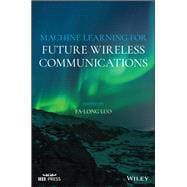A comprehensive review to the theory, application and research of machine learning for future wireless communications
In one single volume, Machine Learning for Future Wireless Communications provides a comprehensive and highly accessible treatment to the theory, applications and current research developments to the technology aspects related to machine learning for wireless communications and networks. The technology development of machine learning for wireless communications has grown explosively and is one of the biggest trends in related academic, research and industry communities.
Deep neural networks-based machine learning technology is a promising tool to attack the big challenge in wireless communications and networks imposed by the increasing demands in terms of capacity, coverage, latency, efficiency flexibility, compatibility, quality of experience and silicon convergence. The author – a noted expert on the topic – covers a wide range of topics including system architecture and optimization, physical-layer and cross-layer processing, air interface and protocol design, beamforming and antenna configuration, network coding and slicing, cell acquisition and handover, scheduling and rate adaption, radio access control, smart proactive caching and adaptive resource allocations. Uniquely organized into three categories: Spectrum Intelligence, Transmission Intelligence and Network Intelligence, this important resource:
- Offers a comprehensive review of the theory, applications and current developments of machine learning for wireless communications and networks
- Covers a range of topics from architecture and optimization to adaptive resource allocations
- Reviews state-of-the-art machine learning based solutions for network coverage
- Includes an overview of the applications of machine learning algorithms in future wireless networks
- Explores flexible backhaul and front-haul, cross-layer optimization and coding, full-duplex radio, digital front-end (DFE) and radio-frequency (RF) processing
Written for professional engineers, researchers, scientists, manufacturers, network operators, software developers and graduate students, Machine Learning for Future Wireless Communications presents in 21 chapters a comprehensive review of the topic authored by an expert in the field.









